Journey in Pisa Timeless Wonder: Leaning Tower of Pisa and Piazza dei Miracoli
Discover the enchanting allure of Pisa’s timeless wonder: the Leaning Tower of Pisa.
Immerse yourself in the captivating beauty of the Piazza dei Miracoli as we embark on a journey through history, art, and architectural marvels.
Pisa is very famous for its square and especially for its leaning tower.
Everybody visiting Pisa wants to take a picture in front of this unique tower and pretend to sustain it with his hand.
The Leaning Tower of Pisa is unique! Do you want to know more about this tower?
Why is the leaning tower of Pisa leaning? Is it a problem? What keeps the leaning tower of Pisa from falling?
Join us as we unravel the secrets and stories behind the leaning tower, an iconic symbol that has captivated hearts and minds for centuries.
Whether you’re a seasoned traveler or a curious explorer, prepare to be awed and inspired by the splendor that awaits in this extraordinary destination.
Walking tour Pisa Piazza dei Miracoli and History
Discover the epitome of Tuscan charm in the most iconic town of Tuscany – Pisa! Immerse yourself in the rich history and timeless wonders of this captivating destination. From the world-famous Leaning Tower to the stunning architectural masterpieces that grace the city, this video takes you on an enchanting journey through Pisa’s cultural heritage. Uncover the secrets behind the Leaning Tower’s intriguing tilt and marvel at the spectacular views from the top. Join us as we unveil the magic of Pisa and its unforgettable allure. Get ready to fall head over heels for this iconic Tuscan town!
You can watch the video directly here or on YouTube at the following link: https://youtu.be/DJeIHQ35m8Q. If you are reading this article from your smartphone, scroll to the bottom of the page and exit the mobile mode to view it directly on this page.
Table of Contents for Journey in Pisa Timeless Wonder: Leaning Tower of Pisa and Piazza dei Miracoli
Text of the video Walking tour Pisa Piazza dei Miracoli and History
Hi everybody, in this video we are in Pisa in Tuscany Italy.
We are now entering the famous Piazza Dei Miracoli in Pisa where we find the city’s most important monuments.
It’s early in the morning, and the souvenir stalls are opening now.
This square is truly unique, and now that it is not yet too crowded with tourists, we can fully admire its beauty.
People from all over the world come to visit this square and its monuments.
Could you tell which is the oldest monument in the whole square?
It is the cathedral, whose construction began in 1064 and ended in 1150.
Construction of the baptistery began in 1152, the walls in 1154, and the Tower in 1173.
But it took centuries to complete the construction of the Tower of Pisa.
In fact, in 1278, when the construction of the Camposanto began, the tower of Pisa was still under construction.
The Tower of Pisa, also due to soil subsidence problems, was completed only in the middle of the following century, but the evolution of the Piazza Dei Miracoli continued until 1863.
When you enter what do you feel? Immediately feel the slope from the base. It’s true, look!
So walking through this square, we can imagine its transformation over time and all the illustrious people of history who have been right here where we are now.
Our tour is ending so I greet you and see you in the next video. Bye!
The Leaning Tower of Pisa
The leaning tower is composed of a cylindrical stone body surrounded by open galleries with arcades and pillars resting on a bottom shaft, with the bell on top.
History of the leaning tower of Pisa
The Leaning Tower of Pisa, a captivating architectural marvel, stands tall in the heart of Italy, a testament to both human ingenuity and the unpredictability of nature. Its story dates back to the 12th century, when construction on the tower began. However, soon after its initial stages, the tower started to lean due to the soft soil beneath its foundation. This unexpected twist became the defining characteristic of the tower, attracting tourists from all corners of the globe. Despite numerous attempts to rectify its tilt, the tower retained its iconic lean, becoming an enduring symbol of resilience and perseverance. Today, the Leaning Tower of Pisa continues to beckon travelers, serving as a reminder of the delicate balance between human ambition and the forces of nature.
Famous people connected to the tower of Pisa
Galileo Galilei, the brilliant Italian mathematician, physicist, and astronomer, is one of the most notable individuals connected to the iconic Tower of Pisa. It was here, in the late 16th century, that Galileo conducted his famous experiment, dropping objects from the tower to study the acceleration due to gravity. His groundbreaking findings revolutionized the scientific understanding of motion and laid the foundation for modern physics. Additionally, the Tower of Pisa has attracted numerous other famous figures throughout history. From Leonardo Fibonacci, the renowned mathematician who introduced the Western world to the Fibonacci sequence, to Pope Boniface VIII, who was instrumental in the tower’s construction, these connections have made the Tower of Pisa an enduring symbol of human ingenuity and cultural significance.
Galileo Galilei and the leaning tower of Pisa
Galileo Galilei, the legendary Italian scientist, and the iconic leaning tower of Pisa share a captivating tale of experimentation and gravity. In the early 17th century, Galileo used the inclined structure of the tower to conduct a groundbreaking experiment on falling objects. With his sharp intellect and keen observation, Galileo dropped objects of different weights from the tower’s top, defying popular beliefs of the time. As each object plummeted towards the earth, Galileo discovered that they all reached the ground simultaneously, regardless of their mass. This pivotal moment in scientific history challenged the established norms and paved the way for the revolution of modern physics. Galileo’s audacious act atop the leaning tower of Pisa forever altered our understanding of the laws of motion and solidified his name as an icon of scientific discovery.
Leonardo Fibonacci and the leaning tower of Pisa
Leonardo Fibonacci, the esteemed Italian mathematician of the 13th century, is forever entwined with the iconic Leaning Tower of Pisa. As he embarked on a journey to unravel the mysteries of numbers, Fibonacci found himself captivated by the enchanting tower that defied gravity. With his mathematical prowess, he couldn’t resist exploring the inclined wonder, pondering its tilt and attempting to decipher its mathematical equation. Little did he know that his fascination with this architectural marvel would inspire his groundbreaking sequence, now known as the Fibonacci sequence, which magically appears in various natural phenomena. From the elegant spirals of seashells to the exquisite patterns of flower petals, Fibonacci’s connection to the leaning tower of Pisa stands as an eternal testament to the interplay between mathematics and the extraordinary beauty of the world around us.
Was the leaning tower of Pisa a mistake?
When the leaning tower of Pisa was built in 1173, nobody made any mistake. Why is the leaning tower of Pisa leaning? However, after a while, the tower caught the attention of several artists for its inclination.
Why is the leaning tower of Pisa leaning?
It was discovered that the ground beneath the tower was essentially made of sand, and shortly after the inauguration, it started to tilt.
This caused an inclination of the tower, which is currently inclined by 3.9 degrees.
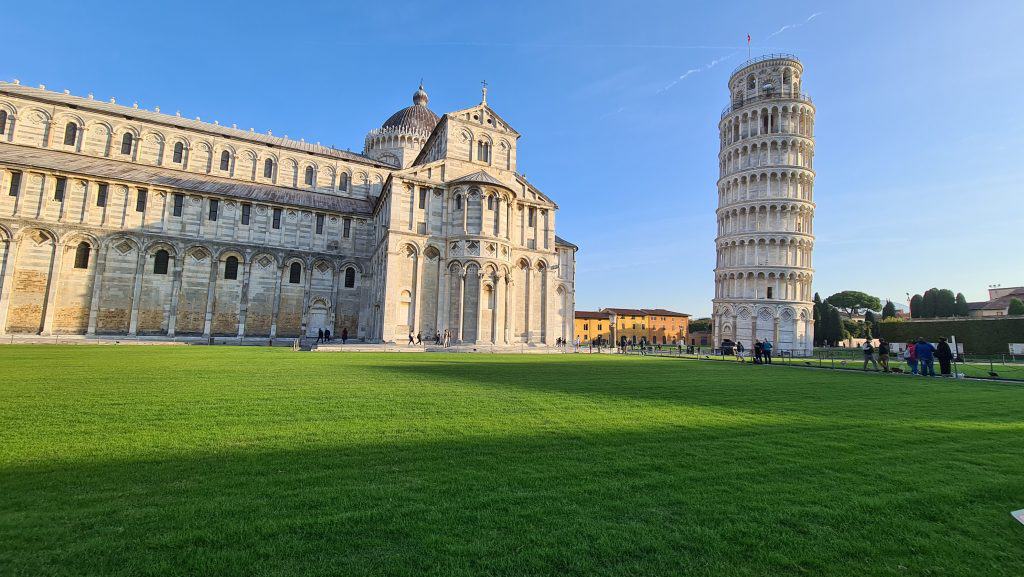
What keeps the leaning tower of Pisa from falling?
The leaning tower of Pisa has not fallen till now thanks to the considerable work of specialized workers who acted to prevent its falling.
The current building is the result of time-consuming reconstruction work, mainly to reduce the risk that the tower might collapse due to its remarkable inclination.
I remember that in past years the tower has been closed to the public for many years. For example, it was closed on January 7th, 1990, and opened again 12 years later. Other times I visited the tower while the workers were working on it.
Why is the Pisa tower so famous?
Apart from its extremely famous inclination that seems to defy the laws of statics, the Tower of the Cathedral is a very unusual building and one of a kind.
This is true for the high historical and artistic value of its forms and because of its peculiar location within that vast and equally unique area, the Piazza Dei Miracoli.
Where is it?
The building is located in Piazza Dei Miracoli but far from the Cathedral, between the apsidal area and the south-eastern section of the transept of the Cathedral.
This is an unusual location although this is not the only case as it can be found in other complexes in town and in other Italian buildings. However, a tower was usually erected near the facade or along one side of the church.
Faqs about Pisa Tower
What causes the Leaning Tower of Pisa to tilt?
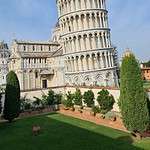
The Leaning Tower of Pisa tilts due to unstable foundation soil, which couldn’t support its weight, leading to a slow, gradual lean during construction in the 12th century.
How tall is the Leaning Tower of Pisa?
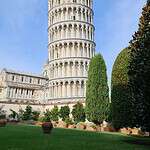
The Leaning Tower of Pisa stands approximately 56 meters (183 feet) tall on the higher side and about 57 meters (186 feet) on the lower side due to its tilt.
Can you climb the Leaning Tower of Pisa?
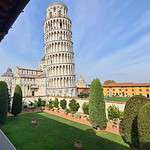
Yes, visitors can climb the 294 steps to the top of the tower, offering stunning views of Pisa and the surrounding area.
Is there an entry fee to visit the Leaning Tower of Pisa?
Yes, there is an entry fee to climb the tower, with tickets typically costing around €20, which includes access to the adjacent cathedral and the baptistery.
What is the best time to visit the Leaning Tower of Pisa?
The best time to visit is during the early morning or late afternoon, avoiding crowds and enjoying softer light for photographs.
How long should I plan to spend at the Leaning Tower of Pisa?
Plan to spend about 1 to 2 hours at the Leaning Tower of Pisa, allowing time to explore the complex, take photos, and enjoy the nearby attractions.
Are there guided tours available for the Leaning Tower of Pisa?
Yes, several guided tours are available that include the tower, the cathedral, and other historical sites in Piazza dei Miracoli, offering deeper insights into their history.
What are the nearby attractions to the Leaning Tower of Pisa?
Nearby attractions include the Pisa Cathedral, the Baptistery, and the Camposanto Monumentale, all located within the Piazza dei Miracoli.
Is the Leaning Tower of Pisa safe to visit?
Yes, the Leaning Tower of Pisa is safe to visit, with ongoing restoration work ensuring its structural integrity and visitor safety.
Can you take photos inside the Leaning Tower of Pisa?
Yes, photography is allowed inside the Leaning Tower of Pisa, but be mindful of other visitors and avoid using flash to preserve the experience.
Inside the Leaning Tower
This stone area accommodates a winding staircase with 293 steps leading up to the open galleries, to the bell on top, and to the lower mezzanine floors. The inner shaft is closed by a vault with a central hole to let light in.
The lower floor, the six open galleries, and the bell divide the tower into eight segments that are called orders.
The lower floor is enriched by a round of blind arcades placed on half-columns. Under the arcade, there is a diamond-shaped compass inlaid with polychrome marble with a raised rosette in the middle.
The solid wall is interrupted by the openings of some narrow single-lancet windows. Westwards it’s also interrupted by the only entrance door: a rectangular area framed by a lintel.
Above the lintel, there is a crescent-shaped arch with an inlaid archivolt. It rests on two capitals as a continuation of the jambs forming a shrine containing the bust of a 14th-century Virgin with a Child.
On the sides of the door, there are some friezes decorated with animals and monstrous figures. There are also the unusual figures of some ships that frame the commemorative epigraph of the foundation of the building.
FAQs
Frequently Asked Questions about the Leaning Tower of Pisa:
What is the oldest monument in Pisa Italy square?
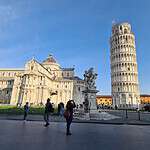
People from all over the world come to visit this square and its monuments. Could you tell which is the oldest monument in the whole square? It is the cathedral, whose construction began in 1064 and ended in 1150.
What is the story behind the Leaning Tower of Pisa?

The tower of Pisa also known as the leaning tower of Pisa is the bell tower of the cathedral of Santa Maria Assunta, in the famous Piazza del Duomo also known as Piazza Dei Miracoli. The construction of the Tower began in 1173.
But it took centuries to complete the construction of the Tower of Pisa.
In fact, in 1278, when the construction of the Camposanto began, the tower of Pisa was still under construction.
The Tower of Pisa, also due to soil subsidence problems, was completed only in the middle of the following century, but the evolution of the Piazza Dei Miracoli continued until 1863.
What keeps the Leaning Tower of Pisa from falling?
The leaning tower of Pisa has not fallen till now, thanks to the considerable work of specialized workers who acted to prevent its falling.
The current building results from time-consuming reconstruction work, mainly to reduce the risk that the tower might collapse due to its remarkable inclination.
I remember that in past years the tower has been closed to the public for many years. For example, it was closed on January 7th, 1990, and opened again 12 years later.
How old is the leaning tower of Pisa?
The construction of the Tower began in 1173.
But it took centuries to complete the construction of the Tower of Pisa.
In fact, in 1278, when the construction of the Camposanto began, the tower of Pisa was still under construction.
The Tower of Pisa, also due to soil subsidence problems, was completed only in the middle of the following century, but the evolution of the Piazza Dei Miracoli continued until 1863.
Can the tower of Pisa fall?
The Leaning Tower of Pisa, with its iconic tilt, stands as a testament to architectural wonder. Yet, in the realm of physics, the question lingers: can this magnificent structure ever succumb to gravity’s pull and topple to the ground? While the tower’s precarious slant may instill doubts, engineers and experts assure us that diligent efforts to stabilize and preserve its integrity have been successful thus far. So, fear not, for the Leaning Tower of Pisa shall continue to defy gravity and stand tall, captivating visitors from around the world.
Featured image
Featured image for Journey in Pisa Timeless Wonder: Leaning Tower of Pisa and Piazza dei Miracoli.
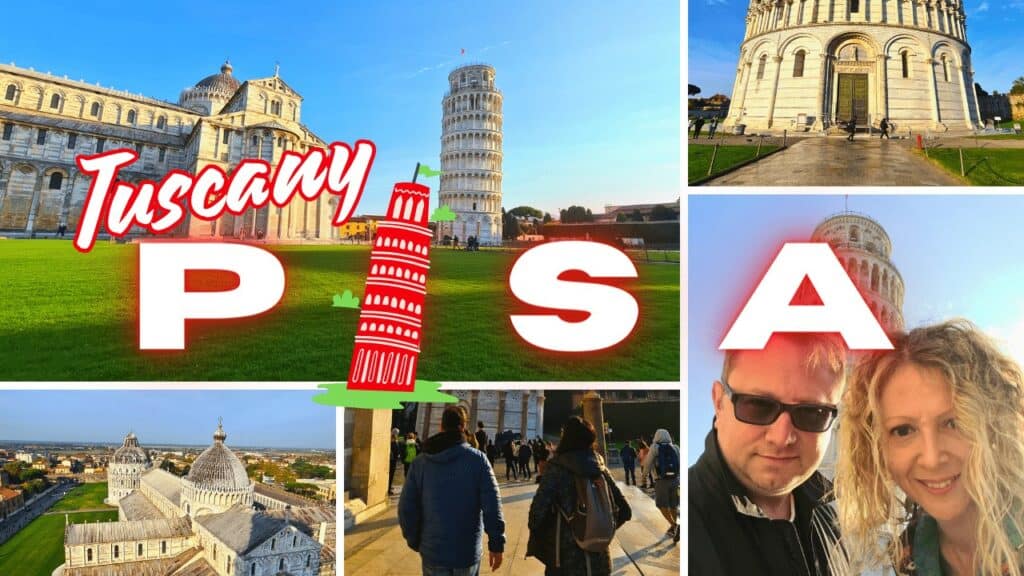
Other Contents
Additional content associated with the post pertains to Pisa and the renowned Leaning Tower of Pisa.
YouTube Channel
Have you already Subscribed to our YouTube Channel? Subscribe here!
Related Posts
Why is the Leaning Tower of Pisa leaning? – Related Posts:
